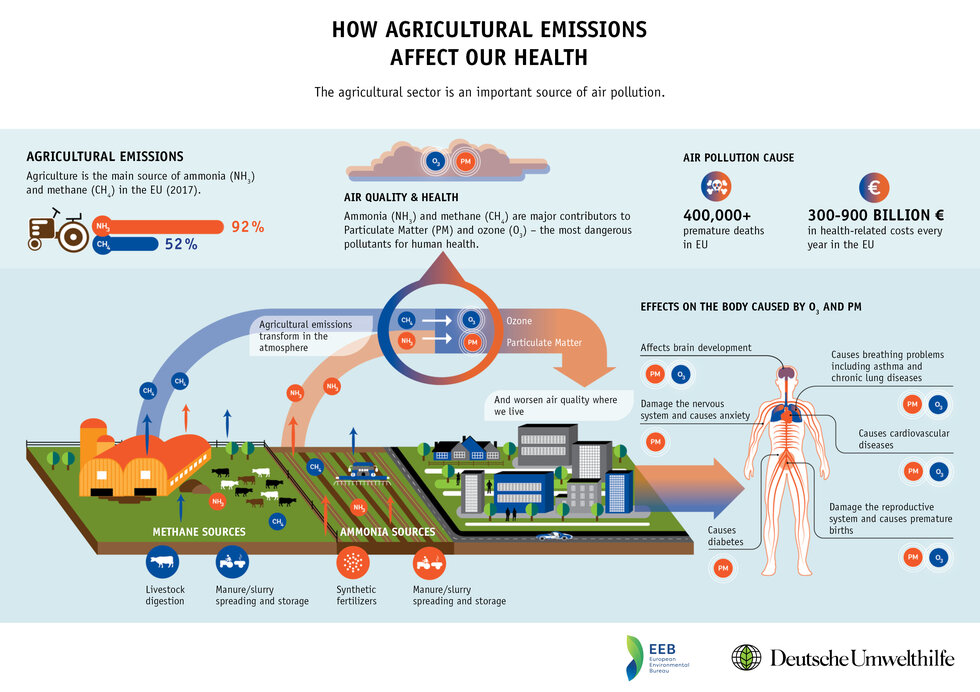Anthropogenic Sources - Agriculture Basic
Reading Guide
Agriculture is a common driver for both air pollution and climate change. Many agricultural activities rely on energy consumption of relevant machinery and equipment, resulting to significant emissions of Greenhouse Gases (GHGs) and air pollutants. The main GHGs associated with agriculture are CO2 and CH4 from livestock and N2O from crop fields. The main air pollutants related to agricultural activities are NH3 and PM (mainly PM2.5 and PM10). PM emitted from agricultural activities account for around 16% of PM10 emissions in the EU emission inventory of 2019. Furthermore, N2O emission from agricultural soil management, as a result of biological nitrification and denitrification processes in soils, is an important contributor in GHGs emissions, accounting for 74% of total N2O emissions in the U.S. According to the latest EU GHG inventory, GHG emissions in the agricultural sector represent almost 10% of the total EU GHG emissions. Fertilizer application in agricultural soils is an important agricultural source of NH3, NOx and N2O emissions, accounting for 93%, 8% and 5.9% of total EU emissions, respectively. Similarly, in both Canada and the US, the agricultural sector is the dominant source of NH3, accounting for 93% of national emissions (Canadian Air Pollutant Emissions Inventory, 2020; US EPA National Emission Inventory, 2020). The alkaline atmospheric ammonia from N fertilizer application is a key precursor to the formation of inorganic fine airborne particulate matter (PM2.5), following the reaction with sulfuric and nitric acid, with significant health, environmental and climatic effects.
In terms of air quality improvement, estimation of agricultural emissions of air pollutants is primarily directed towards national or regional scales. Atmospheric pollutant emissions are calculated by multiplying the activity rate with an emission factor. Emission factors are available from national emission inventories or from dedicated studies in scientific literature. US inventory sources include the Intergovernmental Panel on Climate Change (IPCC) Guidelines for GHGs, and the AP-42 - Compilation of Air Pollutant Emissions Factors report (Fifth Edition, Volume I Chapter 9: Food and Agricultural Industries) for air pollutants related to agriculture. In Europe, the main source of emission factos is the EMEP/EEA air pollutant emission inventory guidebook 2019 and, particularly for agricultural related emissions, the 1A (mobile machinery) and 3D (Crop production and agricultural soils) NFR categories. Emissions can be calculated based on different approaches, depending on the representativity and completeness of available activity data. Tier 1 is the most simple but less accurate approach, as emission estimation is based on default national or international emission factors. Tier 2 method requires an intermediate level of complexity and locally specific data and relies on country-specific emission factors. Tier 3 is the most complex approach, as it relies on the availability of detailed and localized activity information and uses emission factors dependent on a number of fuel combustion variables. Recent research on the estimation of more accurate agricultural NH3 emissions focuses on resolving the temporal variation of emissions using diurnal or seasonal emission profiles.
Material
- EEA Annual European Union greenhouse gas inventory 1990–2017 and inventory report 2019. European Environmental Agency. Published 29 May 2019
- EMEP/EEA EMEP/EEA air pollutant emission inventory guidebook 2019 Technical guidance to prepare national emission inventories. European Environmental Agency. Published 17 October 2019
- Gyldenkærne S., Carsten Ambelas Skjøth, Ole Hertel, Thomas Ellermann (2005). A dynamical ammonia emission parameterization for use in air pollution models. Journal of Geophysical Research 110(7): D07108.10.1029/2004JD005459
- IPCC (2006). 2006 IPCC Guidelines for National Greenhouse Gas Inventories, 4(11). Intergovernmental Panel on Climate Change. Published 2019
- US EPA (2020) National Emission Inventory
Guide prepared by Evangelia Fragkou (08/2022). For corrections or expansions please contact us.
